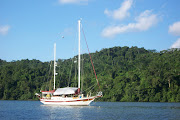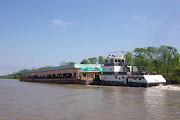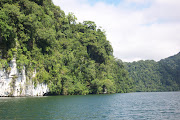These are the kinds of small projects that I like to do over the winter months to have everything ready for any spring cruising we might want to do. The bilge pump switch will be mounted directly over the sub panel for the Air-Conditioning. The switch was originally mounted where the electrical panel is now, but whoever installed the switch did a really sloppy job of cutting the hole, and that was another consideration when deciding where to mount the AC panel. But I did want to keep it close to that location because it was easy to see, and I can reach the manual switch, even when standing in the front of the engine compartment. And because this is a toggle switch, it will be behind the steering wheel, so it can't get bumped accidentally.
 The first thing that I did was to make a template out of a piece of cardboard so that I could get the hole exact and have everything lined up straight. With the template in place, I can trace out the area that needs to be cut out for the switch and LED light with a marker. I then tape around that area with easy release tape so that the wood is not damaged when the cuts are made. Teak plywood can be tricky to cut, and if you are not careful, the plywood will splinter and leave a ragged edge. So I first score the plywood surface with a utility knife to eliminate splitting and chipping, and drill a hole in the center of the cut out area.
The first thing that I did was to make a template out of a piece of cardboard so that I could get the hole exact and have everything lined up straight. With the template in place, I can trace out the area that needs to be cut out for the switch and LED light with a marker. I then tape around that area with easy release tape so that the wood is not damaged when the cuts are made. Teak plywood can be tricky to cut, and if you are not careful, the plywood will splinter and leave a ragged edge. So I first score the plywood surface with a utility knife to eliminate splitting and chipping, and drill a hole in the center of the cut out area. The next step is to cut the hole, and my favorite tool for this, and many other small projects, is my Dremel Tool. I have the saber saw attachment that can be used directly on the Dremel or can be attached to the
The next step is to cut the hole, and my favorite tool for this, and many other small projects, is my Dremel Tool. I have the saber saw attachment that can be used directly on the Dremel or can be attached to the flexible shaft attachment. I am always careful to make my cuts inside the area that I scored with the utility knife. This is the method I use for mounting any switches, electronic displays or gages.
Once the hole is cut I like to insert the switch to be sure there is enough clearance for the inner workings and that the switch can be aligned with everything around it. One work of caution, BEFORE drilling or cutting, check the area behind the spot to be sure you will not drill or cut any plumbing or electrical wiring. Once I am satisfied with everything, a thorough vacuuming is in order. Usually Susan is standing next to me with the vacuum running as I am cutting, sanding or drilling. But this time she was not on the boat, so I have to do a good job in the clean up.
Next step is to connect up all of the wiring. The tools are basic - a good pair of wire strippers, wire cutters, crimpers, my multi-tip screw driver, some wire ties, my favorite wire tie cutters (fingernail clippers), and a tube of silicone grease. With all of the electrical work on the boat, a good coating of silicone grease is added to both sides of every connection. We have almost never had a corrosion problem with any connections over the years using silicone grease. Just as with the larger electrical panels, before I removed the wires from the switch, I labeled them so it would be easy to put them back correctly.
I also like to be sure all of the wires are just long enough that should I have to work on the switch again, I can pull it a distance out of the hole to make working on it or rewiring easier. A bit longer length of wire allows for repairs should the need come up to cut and replace the ends with new connectors. At this point, everything is secured with wire ties to keep it neat.
 The final step is to mount the entire switch. I use a small carpenters level to be sure it is aligned and mark the location of the screw holes. I then drill a small hole where the screws go to keep the wood from splitting. Everything is mounted and looking just as I planned.
The final step is to mount the entire switch. I use a small carpenters level to be sure it is aligned and mark the location of the screw holes. I then drill a small hole where the screws go to keep the wood from splitting. Everything is mounted and looking just as I planned. 
The next switch is the anchor up and down switch, and the process to locate and install that is exactly the same as the bilge pump switch. This one needs to be in a location that is easy to reach while at the helm and since both of us are right handed, the right side of the helm seemed natural. We can also reach it from just outside the sliding door to the main salon, at the steering station. This one took a bit more wiring, since it needed to be run to the reversing switch for the windlass. But it was still simple and straightforward, and now two more items are off the to-do list. On to the next one.












No comments:
Post a Comment
Note: Only a member of this blog may post a comment.